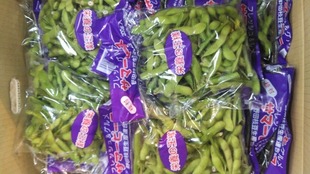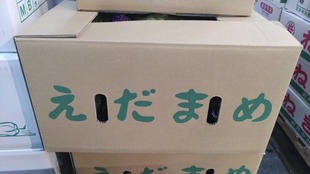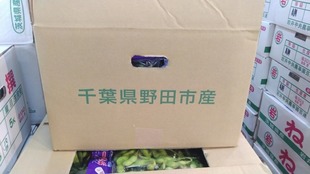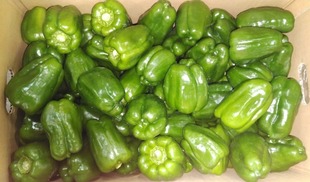The Osugi faith, whose main shrine is Osugi Shrine in Awa, Inashiki City, Ibaraki Prefecture, is also known as "Amba-sama" or "Osugi-sama," and has been widely worshipped around the Tonegawa River system and along the Pacific coast as a god for safe water traffic and the warding off epidemics. In Noda City, sandwiched between the Tone River and the Edogawa River, Osugi festivals are held in many areas in the summer, and the faith is still alive in people's lives.
【Product name】
Summer Peace
It is believed that it was eaten during the Nara and Heian periods. “Green soybeans” are sold as they are attached to the branches, and are called “Edamame” when they are peeled off from the branches. Summer part or fragment. Or is it a piece of summer?
The regular Chiba Prefectural Assembly began a question on June 2, 2022, and Governor Kumagai seems to have stated that "we will promptly prepare for households with many children so that they can implement it within the year" regarding the free school lunch fee. In cooperation with the prefecture's municipalities, it seems that they are aiming to implement it within the fiscal year by compiling the requirements for households to make it free of charge. For households with many children, yard regulations are also being considered. Since 1772, he has been engaged in the soy sauce brewing business under the name of Kashiwaya, and in 1887, the 5th generation Shichiroemon Mogi was appointed as the president when the Noda Soy Sauce Brewing Association was formed. In 1822, the first Fusagoro MOGI abolished his own business and became the guardian of the Mogi Shichirouemon family. Noda City, Chiba Prefecture : The area is 103.55 km2, and topographically, the Tone River and the Edo River branch off at the northernmost tip of the city, and the Tone River to the east, the Edo River to the west, and the Tone Canal to the south surround the river on three sides. It is about 60 km around this embankment, and it is well known as a natural environment that is ideal for walking and jogging as a cycling course. Form a town rich in history, culture and nature. Looking back on history, the northern part prospered around the castle of the Sekiyado Domain, which had a river barrier as the gateway to the big city of Edo, and the southern part was the soy sauce brewing industry that supported the food culture of “Edokko” along with agriculture. In addition, the soy sauce brewing industry has developed, and even now, the urban area is dotted with buildings from the Taisho Era to the early Showa Period, and it is very emotional. In addition, there is a memorial hall that honors former Prime Minister Kantaro SUZUKI, who led the Pacific War to the end, and Mr. Kinjiro SEKINE, the 13th master of modern shogi, who has established a system of talented masters. The Edo Shogunate placed great importance on Sekiyado Castle and placed Fudai Daimyo in Sekiyado for generations. It is well known that the feudal lord lasted for eight families and 23 generations until the end of the Edo period. Among them, Kuze's reign was the longest, and he occupied an important position in the shogunate as he took important positions such as the old and middle ages. Sekiyado Castle in the Edo period hardly exists, but there is a “Chiba Prefectural Sekiyado Castle Museum” that imitates the castle tower, and I have visited it several times. While introducing the history of river improvement and water transportation under the theme of the history of the clan and “Rivers and related industries,” it is an important facility for exhibiting materials related to the people in the basin and the rivers and learning about their hometown. Mr. Kantaro SUZUKI was born in Fuseo, Izumi Province (currently Sakai City, Osaka Prefecture), the eldest son of the Sekiyado Domain, Yutetsu SUZUKI(His maiden name is KURAMOCHI, commonly known as Tamenosuke.), and returned to Sekiyado in 1872. It seems that he moved to. In 1923, he was admiral of the Navy, and later served as Commander-in-Chief of the Allied Fleet and Chamberlain of Emperor Showa. He was appointed Prime Minister on April 7, 1945, leading the Pacific War to the end of the war, and although he was in office for only four months, he returned to Sekiyado after a major role and lived a quiet life. In his hometown, it is a famous story that he started the “Agriculture Study Group” focusing on dairy farming using grass on the riverbed and held lectures by specialized lecturers by taking advantage of the characteristics of the area. Therefore, Noda City is still active in dairy farming and takes root in the area. The “Kantaro Memorial Hall” was opened in 1963 to widely introduce the achievements of the old man, and many relics such as formal wear and daily life items are exhibited, fascinating as a valuable museum. Sekine has been a strong shogi player since he was a child, and by the time he entered elementary school, he had no match for the locals. At the age of 11, he moved to Tokyo with the aim of becoming a professional shogi player, and after repeated training, he was promoted to 4th dan in 1891 and 8th dan in 1905. It was around this time that the third match with Sankichi Sakata, who became the model for the movie “Osho(VS Sankichi SAKATA; 吹けば飛ぶよな 将棋の駒に: コロムビアレコード, The lyrics are Yaso Saijo, the composition is Tooru FUNAMURA, and the song is Hideo MURATA, released in November 1961.)”. This is a Japanese movie released on October 18, 1948, and it is no longer produced. In 1921, after becoming a 13th generation master at the age of 53, he abolished the hereditary system and the whole life master system that had continued for 340 years, and established a championship master system. He laid the foundation for the prosperity of today's shogi world, such as establishing the Japan Shogi Taiseikai, the predecessor of the current Japan Shogi Association, and is widely known as the “father of modern shogi.” As an information dissemination base for shogi, the “關根 Meijin Memorial Hall” constantly displays about 40 items related to masters, and holds about 2,400 books on shogi from the Edo Period to the present day. Next to the memorial hall, there is a 52 tatami mat room where anyone can easily point to shogi, which is unbearable for fans. もの知りしょうゆ館 : At the museum opened by “Kikkoman” in the factory, you can enjoy learning about the color, taste, and aroma of soy sauce while observing the factory until the soy sauce is made. 野田市教育委員会(鶴奉) 2021 “令和2年度 野田市内遺跡発掘調査報告” : 上野馬込遺跡, 第15次(花井新田字三丁歩), 宅地造成, 集落, 古墳 / 近世(細分不明) 時代. 山崎貝塚周辺遺跡, 第25次, 分譲宅地, 集落, 縄文時代, 縄文時代土器. 中野台貝塚, 第5次 / 本調査(字行人谷), 個人住宅, 貝塚, 縄文時代, 縄文時代竪穴建物1, 土坑, Pit, 縄文時代: 土器, 縄文時代: 石器. 岡部館跡(山崎字梅台), 宅地造成, 城館, 中世(細分不明), 近世(細分不明) 時代, 古墳時代土坑1, 縄文時代土器, 石器, 古墳時代中期土師器. 東新田野馬土手(山崎字殿山), 戸建分譲, 中世 (細分不明), 近世(細分不明) 時代, 中世~近世野馬堀1. 山崎貝塚周辺遺跡, 第26次, 個人, 集落, 縄文. 岩名新屋敷遺跡(字宮田), 個人住宅, 縄文 / 中世(細分不明), 近世(細分不明) 時代, 中近世溝1 , 縄文時代土器, 中近世土師質土器. 溜井遺跡, 第4次(吉春字溜井), 駐車場, 縄文 / 中世 (細分不明), 近世 (細分不明) 時代, 中近世塚1. In the early Edo period, the goods transportation route from Choshi Port to Edo via the Tone River passed through Omori, Shirai, Kamagaya, and Yawata by land between Kinoshita and Hongyotoku. Due to the improvement of the Tone River channel and the renovation of the Edo River, boat transportation was opened and this gradually became more important. Kinoshita and Hongyo Tokuma were loaded with horses, and there was a process of switching to boat transportation. In 1716, the boat routes of Fusa, Matsudo, and Edo were developed, and the land routes gradually declined, and villages petitioned the shogunate. As the population of Edo increases, vegetable production in nearby rural areas expands. The production areas expanded in parallel to the plateau area in the western part of Edo and the island field area in the east, but the production area in the eastern part expanded from Adachi / Minami Katsushika to Higashi Katsushika. One of the ways of spreading was to head for Yawata and Kamagaya by land, and the other was to head for Ichikawa and Matsudo by waterway. At the end of the Edo period, the routes between these production areas and Edo were complicated in the western part of Higashi Katsushika, and it seems that boat transportation was made from Yamanaka / Funabashi and bad transportation was made from Ichikawa / Matsudo. The types of vegetables produced are those from nearby production areas that have expanded their production areas, but many of them have already been made for private use in the production areas of Higashi Katsushika. Most of them lack records of introduction, but some are said to be folklore. In 1801, Chozaemon Hanazawa of Yabashira Village Ohashi introduced Mitsuba from Mizumoto Village (currently Katsushika Ward) and started cultivation, and from 1804, Mr. Magoemon Ukiya of Yabashira Village Wanagaya started cultivating Mitsuba. With shipments to Senju, the nearby production areas have expanded from the island fields to the plateau areas. It is said that the shipment to Senju was done with a crap and a shoulder. In 1803, Ichikawa made melons, watermelons, radishes, eggplants, etc. and sold them to Edo through the banks of the Gyotoku River by boat transportation. Vegetable production in Higashi Katsushika seems to have increased sharply during the Kyoho year in response to the increase in demand in Edo. According to Ichikawa, “Around this time, the demand for vegetables in Edo increased, and local farmers tried to increase their productivity by using lower fertilizer to meet this demand.” From Genroku to Hoei, farmers near Edo used to fetch the inhabitants' lower fertilizer for free, but after that, they were charged a fee and changed to purchasing. The landlord / landlord owns the right to sell the lower fertilizer, and sells the actual product to the merchant, who sells the purchased lower fertilizer to the suburbs. It seems that the ship was called “Kasai ship”. The shogunate is monitoring the sale of manure, and it is recorded that in 1792 the shogunate ordered the Kasai ship to reduce the price of manure. The use of manure in vegetable cultivation gradually became widespread, for example, in 1838 in Higashi Katsushika: It is said that the peasant family of Kashiwai village can know by making melons, watermelons, potatoes, and radishes and selling them to Edo, and relying on the Shimogoe(Human manure as fertilizer)Ship (Kasai Ship) for fertilizer. In addition, Taro, melon, and watermelon were mentioned as products for sale, and transactions were not limited to the suburbs of Horie, Nakayama, and Onikoshi villages, but also to Asakusa and Honjo. Instead, he said he purchased manure, dried sardines, oil cake, etc., indicating the establishment of a nearby vegetable producing area. As the range of Shimogoe purchases expanded and disputes arose between farmers and traders, 1846 “The Shogunate set the price of manure with officials under the control of the account magistrate. It covers the territories of Hirayanagi, Yakota, Fuchie, Nishikasai, Higashikasai, and Gyotoku.” Kumaji Shibutani of Matsudo Shimoyakiri obtained green onion seeds from Shimazaki of Shibamata, Kanamachi Village, Minamikatsushika District and started cultivating them in 1852, on the opposite bank of Shimoyakiri across the Shiba or Edo River. The variety is "Senju welsh onion", and Kanamachi village has already been producing green onions. In addition, until the end of the Edo period, Mitsuba in Higashi Katsushika District was mostly softened in winter, and it seems that intensive vegetable cultivation was being carried out rather than extensive root mitsuba cultivation. For the production of vegetables in Higashi Katsushika, the Meiji era was an era in which the production area was greatly advanced in response to the increase in demand for vegetables in Tokyo under the capitalist economy. Not only has the variety and quantity of vegetables increased, but we have also endeavored to introduce new varieties of the same type, incorporated hotbed cultivation into the cultivation method to extend the shipping period, and introduced crop rotation to centralize production / shipment and land use. And efforts to promote rationalization were used as food. Quantitative production had already progressed in the first year of the Meiji era, but as the number of kansho, watermelon, radish, carrot, burdock, eggplant, melon, cucumber, squash, etc. gradually increased, onions, watermelons, melons, ginger, etc. Production of melons and other products increased fashionably due to an increase in supply and demand. It was Mitsuba that surged in Hongo in the first year of the Meiji era, and cultivation increased in Takagi and Kamagaya centering on the eight pillars, and it was sold to the Capital Area Tokyo market and local merchants, and its production area was permanent. From the 1887 to the 1889s, vegetable production in this area increased significantly because the population of Tokyo increased and demand increased in the wake of the Sino-Japanese War, and the opening of the Joban Line in 1896 led to Matsudo. The rapid growth of local vegetable cultivation and the opening of the Sobu Line in 1897 increased vegetable cultivation in the southern part of Higashi Katsushika. Noda City, located at the northernmost tip of Chiba Prefecture, is a major edamame producing area. It is said that edamame cultivation began in Noda City in the mid-1950s. Since edamame loses its taste quickly after being harvested, it has built its position while taking advantage of its proximity to Tokyo, which is a large consumption area. It is well known that the city is enthusiastic about the “Noda Edamame” brand. The cultivated area is as large as about 300 ha(3 km2, 3000000 m2, 30000000000 cm2, 741.3ac, 1.1583 mi2, 3588000 yd2, 32280000 ft2, 4650000000 in2, about 907500 坪, about 90750000 勺). Cultivation in the city began in the latter half of the 1945s, and at that time many farmers were growing soybeans for making their own miso. The food situation has gradually recovered, so it seems that they have switched from soybeans to edamame. In the city, we used to collect green soybeans such as “Nishiarai and Mikawashima” on behalf of a seedling supplier, so some farmers use these varieties to grow green soybeans in the Asahi area of Noda City. It was the Mefuki Shipping Association in Noda City that systematically cultivated and shipped the products in 1957, and then spread throughout the city centering on the Asahi district. At that time, most of the plants were sown directly from early April to mid-April and harvested from late July to early August. It was in 1965 that transplant cultivation was carried out using Okuhara No. 1 and early-out cultivation was attempted, and in 1968, multi-cultivation was also carried out. The city's edamame is characterized by the fact that part-time farmers are as powerful as full-time farmers. Cultivation is a relatively reasonable crop rotation system with spinach from autumn to spring and green soybeans at high temperatures in summer. In addition, since there are more than 85% of dual-purpose farmers, it is not suitable for those that require advanced technology such as fruits and vegetables. In this respect, crop rotation of green soybeans and spinach is technically and economically suitable for the city. There seems to be. The current cropping type is said to be cultivated in four cropping types: tunnel and mulch, tunnel cultivation, mulch cultivation, and open field cultivation. Below, most of them are transplanted and cultivated. In this transplanting cultivation, the previous crop has a fertile field for cultivating leaves such as spinach, which helps prevent the growth of green soybeans and overgrowth. Most of the varieties are “Okuhara Wase” and “Hakucho” released in June, and many varieties such as “Toya”, “Sappro Midori” and “Yukimusume” have been introduced recently in July. Sowing is carried out sequentially from the beginning of March, and the seedling raising period is around 20 days. The final sowing is in early June, and the quality of edamame in August deteriorates due to damage such as Asphondylia yushimai(Adults lay eggs one by one on the inner surface of young pods at night. The damaged pods and the grains inside stop growing as they are, and a part of the pods swells small and becomes galls. When the gall is cracked, a white cotton-like substance can be seen inside, which is a hypha of the fungus that develops when the hatched larva grows, and is in a symbiotic relationship with the Sayatama fly. The pupae are characterized by the fact that the damaged pupae often have pupal shells attached to them because the pupae have an escape hole made in the pod with a saw blade-shaped protrusion at the tip of the head and the half of the body leans out to escape. After the pupae have escaped, the inner surface of the pod is often discolored from grayish black to orange-brown. Late species are more susceptible to damage, as outbreaks are more frequent from mid-August to September. It tends to be distributed south of Honshu. Repeat for several generations from June to November. The peak outbreak is in mid-July in Kyushu and in September in the Kanto and Tohoku regions. Adults fly in the evening, mate and lay eggs on young pods. The larvae develop in the pods, pupate in about 3 weeks, and emerge in about 5 days. Adults look like “mosquitoes”. The larvae are yellow-red translucent maggots that pupate inside the pods, and the pupae emerge from the outside of the pods and emerge, leaving escape shells on the pods. Since it flies from the flowering period to the young pods and lays eggs, the chemicals are controlled twice aiming at the pods. Cultivation control method: For summer soybeans, selection of early-maturing seeds so that flowering ends by the end of June or early sowing (after April) will cause less damage. Sumithion is registered for the control of soybean Cecidomyiidae of various legumes. Check the registered contents carefully.), so we aim to ship it by July.
Like mature soybeans, it is rich in energy, fat and good protein. In addition, it contains vitamins A and C, which are not found in soybeans, and is rich in vitamin B1. Vitamin B1 improves the metabolism of sugar and keeps nerve function normal, so it seems to be useful for recovery from fatigue and prevention of summer heat fatigue. In addition, the substance C5H11NO2S contained in the protein, along with vitamins A, B1 and C, helps the decomposition of alcohol and reduces the burden on the liver. It makes sense to eat it as a snack for sake. Since the pods are boiled, it seems that the nutritional components do not change so much even if boiled.
In Japan, many small beans such as crane beans and mung beans have been excavated from the Jomon archaeological site, and the excavation of large beans such as soybeans has not yet been confirmed. However, in recent years, it was discovered as a plant indentation inside the earthenware excavated, and it seems that its existence in the Japanese archipelago has been confirmed from the middle to late Jomon period. It is possible that cultivated soybeans were brought from the continent before this time, or that vine beans were cultivated independently in the Japanese archipelago, but it seems that it is not known exactly.
There is a edamame motif bus called "Mame Bus" in Noda City! It boasts one of the largest shipments of green soybeans in Japan, and in 2002, it became the number one shipment in Japan. Since the taste of green soybeans deteriorates immediately after harvesting, the green soybeans produced in Noda, which are traded in the market in Tokyo on the day of harvesting, are highly evaluated and are a brand agricultural product representing Chiba prefecture. The edamame owner system allows farmers to harvest edamame cultivated by themselves. Although it is a harvesting place, it is a edamame farm in the city (the place cannot be specified). The harvest time is from early to mid-July (contact from the farm at the appropriate time for harvesting), but the standard is to harvest 13 bags of 300 grams per plot. As a guide, the target is those who can come to harvest. The price seems to be 3,000 yen per block.






No comments:
Post a Comment